Statistics Hypothesis Testing Assignment
VerifiedAdded on 2020/03/23
|5
|846
|367
Homework Assignment
AI Summary
This assignment focuses on hypothesis testing in statistics, covering various scenarios including z tests and t tests. It involves analyzing sample data to determine statistical significance and confidence intervals, providing a comprehensive understanding of statistical methods.
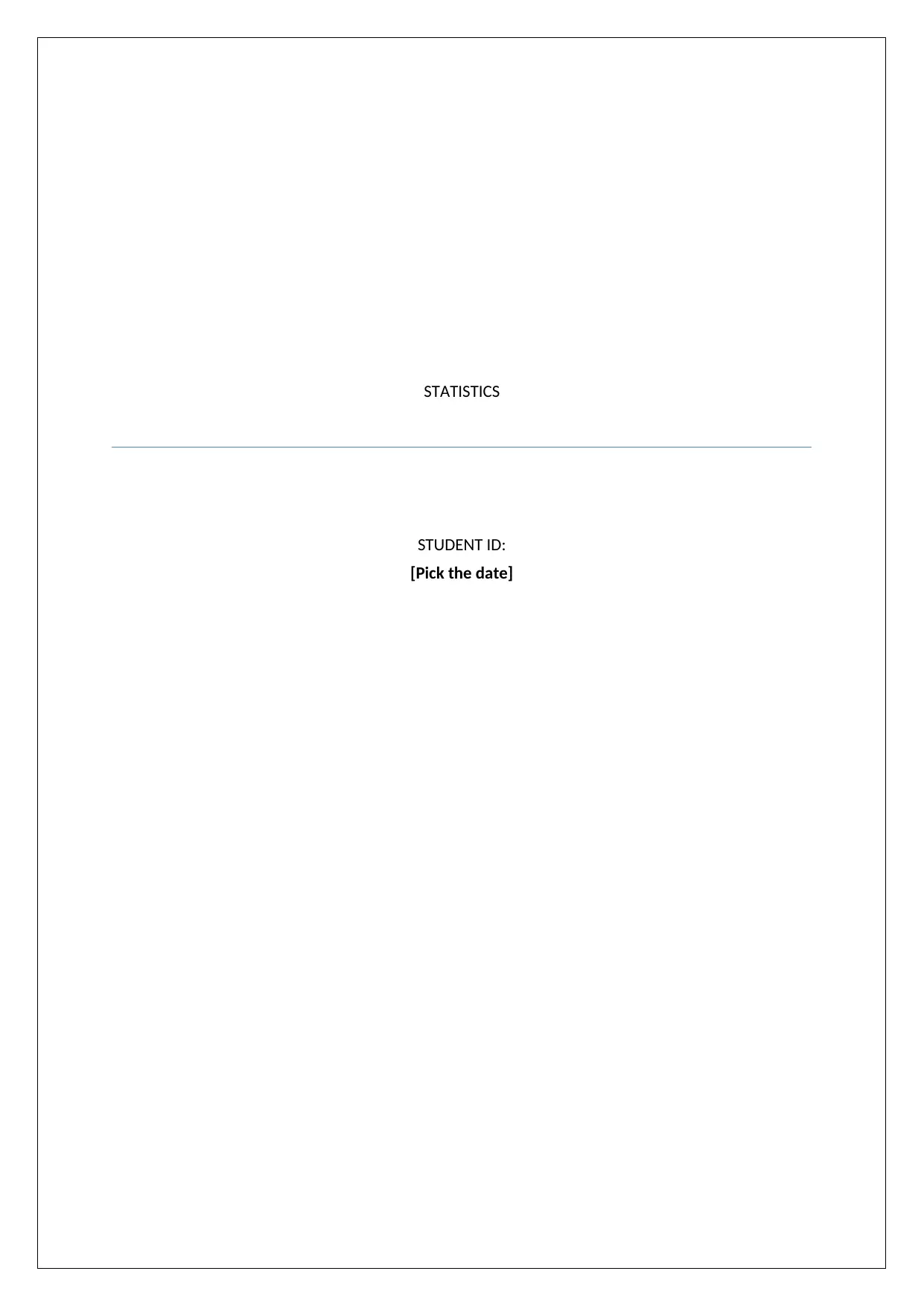
STATISTICS
STUDENT ID:
[Pick the date]
STUDENT ID:
[Pick the date]
Paraphrase This Document
Need a fresh take? Get an instant paraphrase of this document with our AI Paraphraser
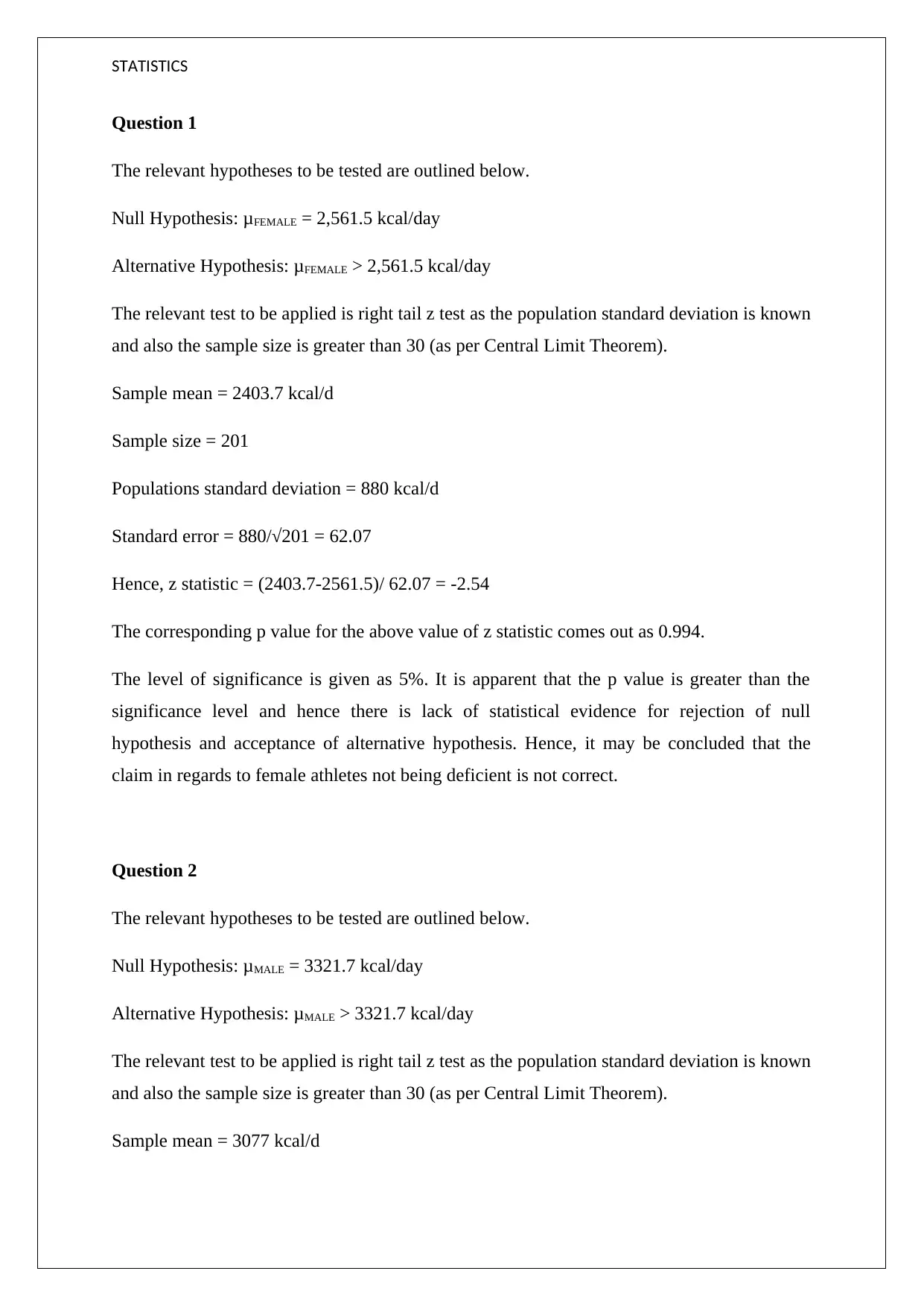
STATISTICS
Question 1
The relevant hypotheses to be tested are outlined below.
Null Hypothesis: μFEMALE = 2,561.5 kcal/day
Alternative Hypothesis: μFEMALE > 2,561.5 kcal/day
The relevant test to be applied is right tail z test as the population standard deviation is known
and also the sample size is greater than 30 (as per Central Limit Theorem).
Sample mean = 2403.7 kcal/d
Sample size = 201
Populations standard deviation = 880 kcal/d
Standard error = 880/√201 = 62.07
Hence, z statistic = (2403.7-2561.5)/ 62.07 = -2.54
The corresponding p value for the above value of z statistic comes out as 0.994.
The level of significance is given as 5%. It is apparent that the p value is greater than the
significance level and hence there is lack of statistical evidence for rejection of null
hypothesis and acceptance of alternative hypothesis. Hence, it may be concluded that the
claim in regards to female athletes not being deficient is not correct.
Question 2
The relevant hypotheses to be tested are outlined below.
Null Hypothesis: μMALE = 3321.7 kcal/day
Alternative Hypothesis: μMALE > 3321.7 kcal/day
The relevant test to be applied is right tail z test as the population standard deviation is known
and also the sample size is greater than 30 (as per Central Limit Theorem).
Sample mean = 3077 kcal/d
Question 1
The relevant hypotheses to be tested are outlined below.
Null Hypothesis: μFEMALE = 2,561.5 kcal/day
Alternative Hypothesis: μFEMALE > 2,561.5 kcal/day
The relevant test to be applied is right tail z test as the population standard deviation is known
and also the sample size is greater than 30 (as per Central Limit Theorem).
Sample mean = 2403.7 kcal/d
Sample size = 201
Populations standard deviation = 880 kcal/d
Standard error = 880/√201 = 62.07
Hence, z statistic = (2403.7-2561.5)/ 62.07 = -2.54
The corresponding p value for the above value of z statistic comes out as 0.994.
The level of significance is given as 5%. It is apparent that the p value is greater than the
significance level and hence there is lack of statistical evidence for rejection of null
hypothesis and acceptance of alternative hypothesis. Hence, it may be concluded that the
claim in regards to female athletes not being deficient is not correct.
Question 2
The relevant hypotheses to be tested are outlined below.
Null Hypothesis: μMALE = 3321.7 kcal/day
Alternative Hypothesis: μMALE > 3321.7 kcal/day
The relevant test to be applied is right tail z test as the population standard deviation is known
and also the sample size is greater than 30 (as per Central Limit Theorem).
Sample mean = 3077 kcal/d
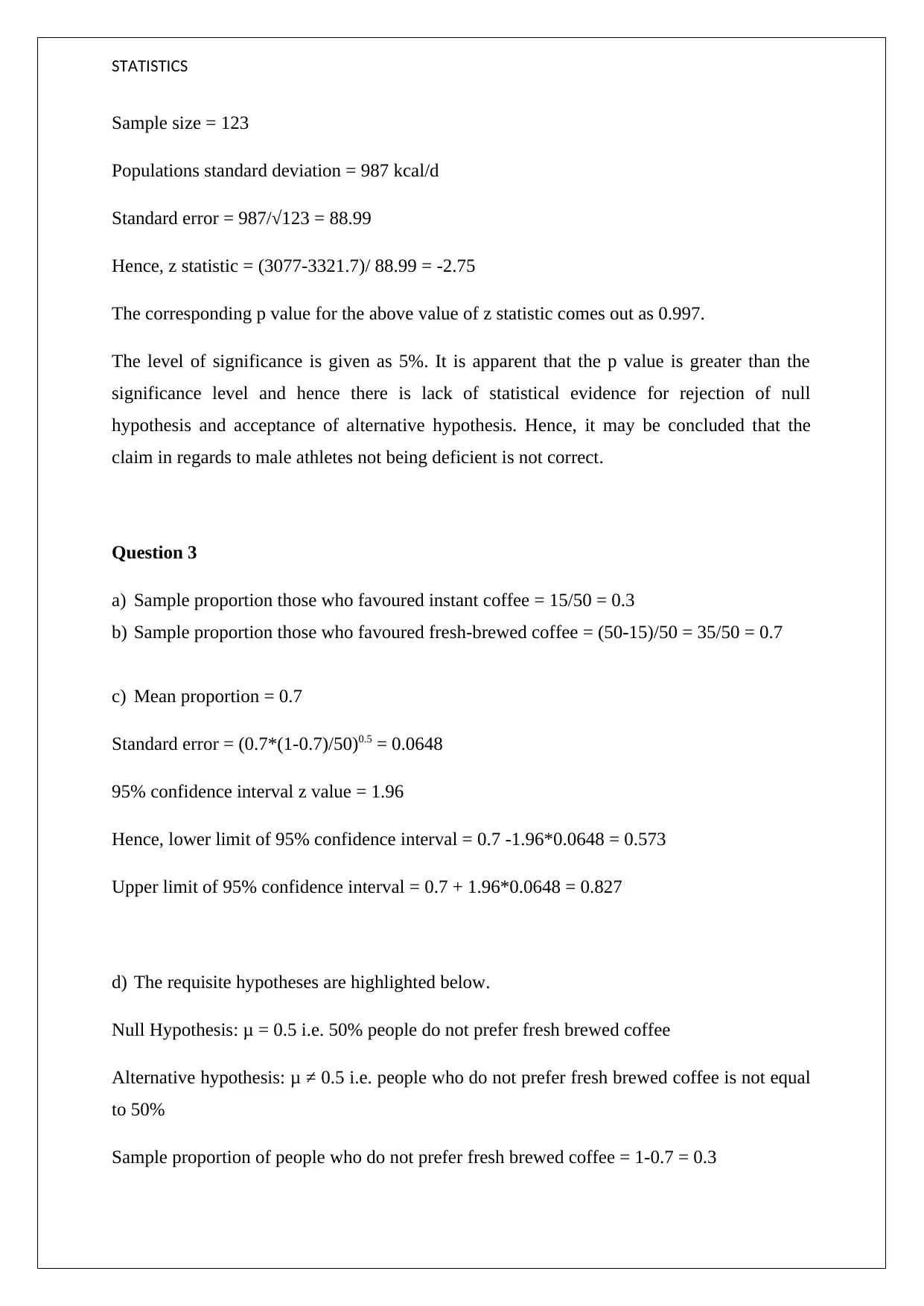
STATISTICS
Sample size = 123
Populations standard deviation = 987 kcal/d
Standard error = 987/√123 = 88.99
Hence, z statistic = (3077-3321.7)/ 88.99 = -2.75
The corresponding p value for the above value of z statistic comes out as 0.997.
The level of significance is given as 5%. It is apparent that the p value is greater than the
significance level and hence there is lack of statistical evidence for rejection of null
hypothesis and acceptance of alternative hypothesis. Hence, it may be concluded that the
claim in regards to male athletes not being deficient is not correct.
Question 3
a) Sample proportion those who favoured instant coffee = 15/50 = 0.3
b) Sample proportion those who favoured fresh-brewed coffee = (50-15)/50 = 35/50 = 0.7
c) Mean proportion = 0.7
Standard error = (0.7*(1-0.7)/50)0.5 = 0.0648
95% confidence interval z value = 1.96
Hence, lower limit of 95% confidence interval = 0.7 -1.96*0.0648 = 0.573
Upper limit of 95% confidence interval = 0.7 + 1.96*0.0648 = 0.827
d) The requisite hypotheses are highlighted below.
Null Hypothesis: μ = 0.5 i.e. 50% people do not prefer fresh brewed coffee
Alternative hypothesis: μ ≠ 0.5 i.e. people who do not prefer fresh brewed coffee is not equal
to 50%
Sample proportion of people who do not prefer fresh brewed coffee = 1-0.7 = 0.3
Sample size = 123
Populations standard deviation = 987 kcal/d
Standard error = 987/√123 = 88.99
Hence, z statistic = (3077-3321.7)/ 88.99 = -2.75
The corresponding p value for the above value of z statistic comes out as 0.997.
The level of significance is given as 5%. It is apparent that the p value is greater than the
significance level and hence there is lack of statistical evidence for rejection of null
hypothesis and acceptance of alternative hypothesis. Hence, it may be concluded that the
claim in regards to male athletes not being deficient is not correct.
Question 3
a) Sample proportion those who favoured instant coffee = 15/50 = 0.3
b) Sample proportion those who favoured fresh-brewed coffee = (50-15)/50 = 35/50 = 0.7
c) Mean proportion = 0.7
Standard error = (0.7*(1-0.7)/50)0.5 = 0.0648
95% confidence interval z value = 1.96
Hence, lower limit of 95% confidence interval = 0.7 -1.96*0.0648 = 0.573
Upper limit of 95% confidence interval = 0.7 + 1.96*0.0648 = 0.827
d) The requisite hypotheses are highlighted below.
Null Hypothesis: μ = 0.5 i.e. 50% people do not prefer fresh brewed coffee
Alternative hypothesis: μ ≠ 0.5 i.e. people who do not prefer fresh brewed coffee is not equal
to 50%
Sample proportion of people who do not prefer fresh brewed coffee = 1-0.7 = 0.3
⊘ This is a preview!⊘
Do you want full access?
Subscribe today to unlock all pages.

Trusted by 1+ million students worldwide
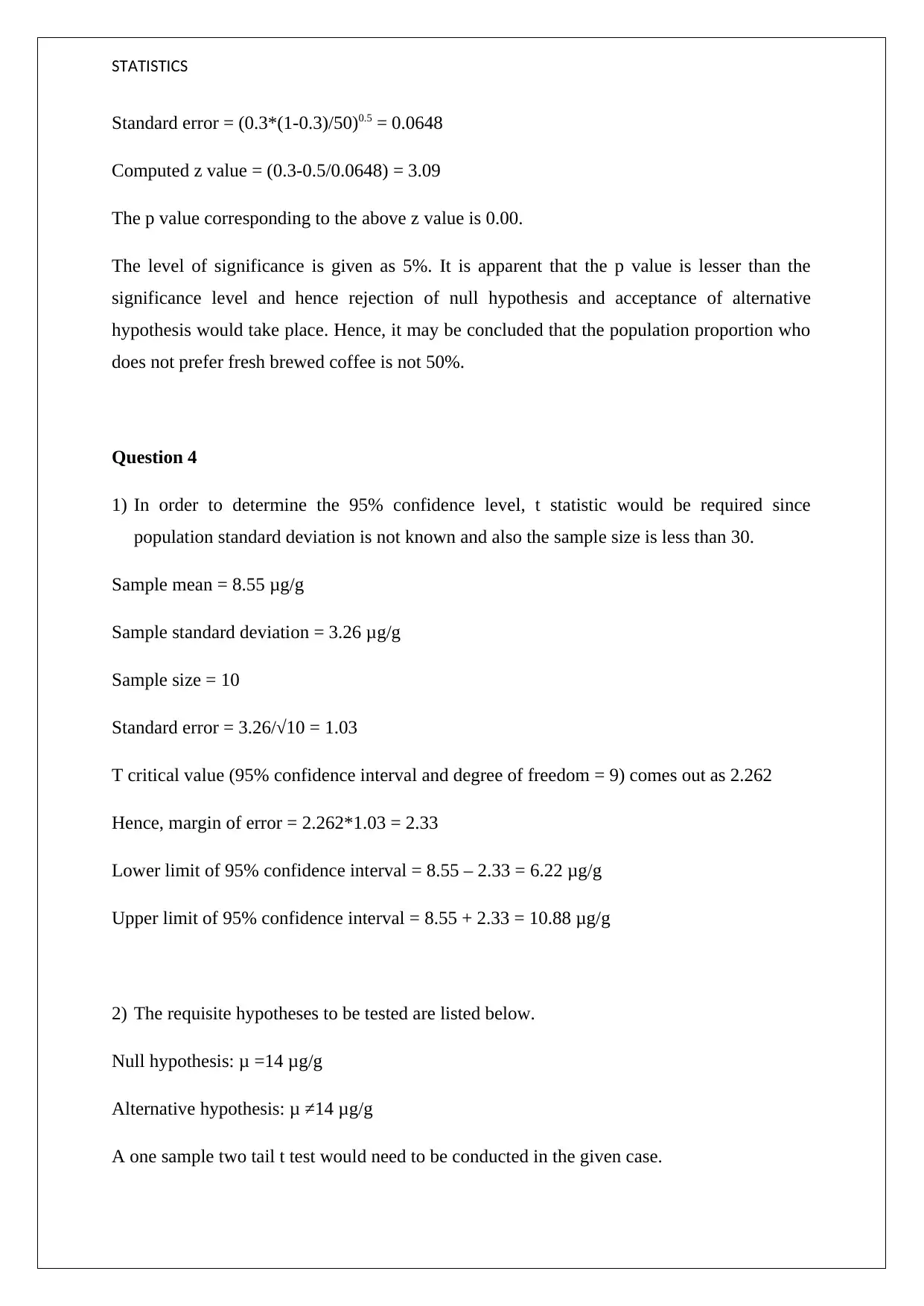
STATISTICS
Standard error = (0.3*(1-0.3)/50)0.5 = 0.0648
Computed z value = (0.3-0.5/0.0648) = 3.09
The p value corresponding to the above z value is 0.00.
The level of significance is given as 5%. It is apparent that the p value is lesser than the
significance level and hence rejection of null hypothesis and acceptance of alternative
hypothesis would take place. Hence, it may be concluded that the population proportion who
does not prefer fresh brewed coffee is not 50%.
Question 4
1) In order to determine the 95% confidence level, t statistic would be required since
population standard deviation is not known and also the sample size is less than 30.
Sample mean = 8.55 μg/g
Sample standard deviation = 3.26 μg/g
Sample size = 10
Standard error = 3.26/√10 = 1.03
T critical value (95% confidence interval and degree of freedom = 9) comes out as 2.262
Hence, margin of error = 2.262*1.03 = 2.33
Lower limit of 95% confidence interval = 8.55 – 2.33 = 6.22 μg/g
Upper limit of 95% confidence interval = 8.55 + 2.33 = 10.88 μg/g
2) The requisite hypotheses to be tested are listed below.
Null hypothesis: μ =14 μg/g
Alternative hypothesis: μ ≠14 μg/g
A one sample two tail t test would need to be conducted in the given case.
Standard error = (0.3*(1-0.3)/50)0.5 = 0.0648
Computed z value = (0.3-0.5/0.0648) = 3.09
The p value corresponding to the above z value is 0.00.
The level of significance is given as 5%. It is apparent that the p value is lesser than the
significance level and hence rejection of null hypothesis and acceptance of alternative
hypothesis would take place. Hence, it may be concluded that the population proportion who
does not prefer fresh brewed coffee is not 50%.
Question 4
1) In order to determine the 95% confidence level, t statistic would be required since
population standard deviation is not known and also the sample size is less than 30.
Sample mean = 8.55 μg/g
Sample standard deviation = 3.26 μg/g
Sample size = 10
Standard error = 3.26/√10 = 1.03
T critical value (95% confidence interval and degree of freedom = 9) comes out as 2.262
Hence, margin of error = 2.262*1.03 = 2.33
Lower limit of 95% confidence interval = 8.55 – 2.33 = 6.22 μg/g
Upper limit of 95% confidence interval = 8.55 + 2.33 = 10.88 μg/g
2) The requisite hypotheses to be tested are listed below.
Null hypothesis: μ =14 μg/g
Alternative hypothesis: μ ≠14 μg/g
A one sample two tail t test would need to be conducted in the given case.
Paraphrase This Document
Need a fresh take? Get an instant paraphrase of this document with our AI Paraphraser
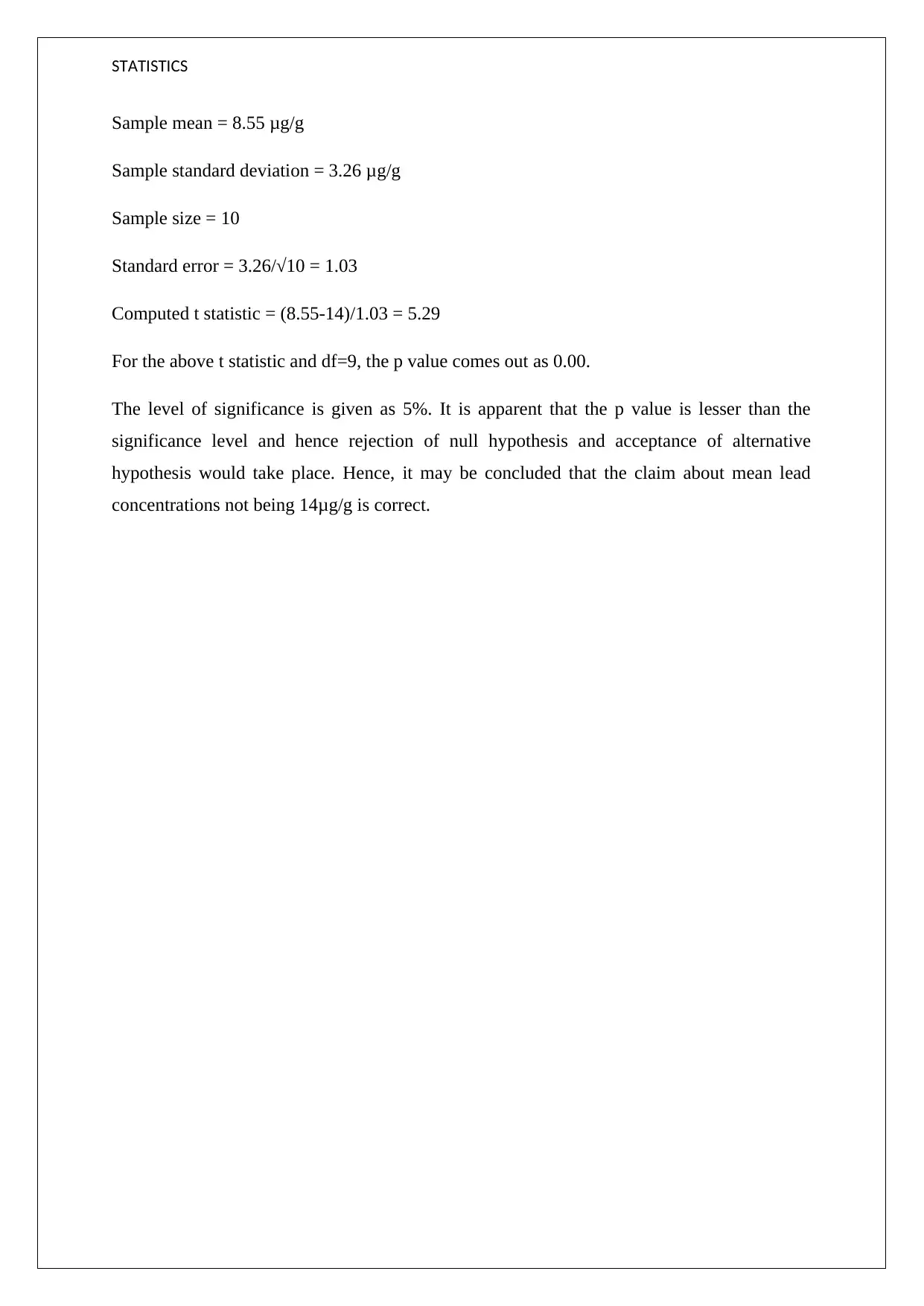
STATISTICS
Sample mean = 8.55 μg/g
Sample standard deviation = 3.26 μg/g
Sample size = 10
Standard error = 3.26/√10 = 1.03
Computed t statistic = (8.55-14)/1.03 = 5.29
For the above t statistic and df=9, the p value comes out as 0.00.
The level of significance is given as 5%. It is apparent that the p value is lesser than the
significance level and hence rejection of null hypothesis and acceptance of alternative
hypothesis would take place. Hence, it may be concluded that the claim about mean lead
concentrations not being 14μg/g is correct.
Sample mean = 8.55 μg/g
Sample standard deviation = 3.26 μg/g
Sample size = 10
Standard error = 3.26/√10 = 1.03
Computed t statistic = (8.55-14)/1.03 = 5.29
For the above t statistic and df=9, the p value comes out as 0.00.
The level of significance is given as 5%. It is apparent that the p value is lesser than the
significance level and hence rejection of null hypothesis and acceptance of alternative
hypothesis would take place. Hence, it may be concluded that the claim about mean lead
concentrations not being 14μg/g is correct.
1 out of 5
Related Documents
Your All-in-One AI-Powered Toolkit for Academic Success.
+13062052269
info@desklib.com
Available 24*7 on WhatsApp / Email
![[object Object]](/_next/static/media/star-bottom.7253800d.svg)
Unlock your academic potential
Copyright © 2020–2025 A2Z Services. All Rights Reserved. Developed and managed by ZUCOL.




